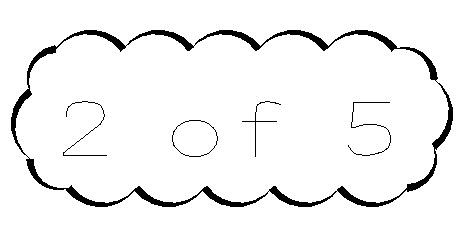Revision Clouds in DraftSight
In the world of design and drafting, one thing is inevitable: change. Revision cycles represent a significant part of a drawing’s lifecycle. A typical workflow includes a short narrative in the revision block of the sheet’s title block, a corresponding identity mark, usually a letter or number within a triangle (a delta), and a scalloped cloud enclosing the area of revision.
DraftSight makes it easy to create and add revision clouds to your drawing. Plus, it offers a lot of flexibility for creating them. You can find the Cloud command and its options pulldown in the Markup panel of the ribbon’s Annotate tab.

Notice that you have four creation options and a settings menu item. You can see an example of the first three below. If you’ve spent any time in DraftSight, you should already know how to create them. The rectangular style is like drawing a DraftSight Rectangle entity; just pick two opposite corners. Elliptical is just like the Ellipse entity, and FreeHand is like drawing a free-form polyline.

The last style, Entity, allows you to select closed entities, such as rectangles, polylines, circles, ellipses, and splines, to turn them into revision clouds. As shown in the animation below, we use this method to change the rectangle into a Cloud.


While it’s always good practice to keep your eye on the Command Window in DraftSight, it’s especially good practice when creating Clouds. As we said earlier, you have lots of options. During creation, you’ll be prompted to use either the Normal or Calligraphy style (more on that in a moment), and you’ll have the opportunity to reverse the direction of the arcs.
You can also specify T for Settings, and you’ll be able to use the handy Cloud dialog box, which will let you make all your settings and choices before creating your Cloud.

Finally, you can create your Cloud using the stylized Calligraphy style. This is a good time to mention that the Cloud command creates a PolyLine with multiple vertices spaced per your defined radius. Between each vertex, DraftSight creates an arc. When the Calligraphy style is specified, Cloud will taper the width of the PolyLine from the start point to the endpoint.

Summing Up
As you’ve seen, that’s a lot of options, and most CAD Standards will have a section on exactly how revision clouds are created in that department. The good news is that it’s a perfect place for an enterprising CAD Manager to create a script or Lisp routine that will do it for you.
And here’s some more good news: You can try it all out yourself for free with the 30-day trial of DraftSight Premium, which you can find here.
We get it… revisions happen. But with DraftSight, you can handle them more easily when they do.



